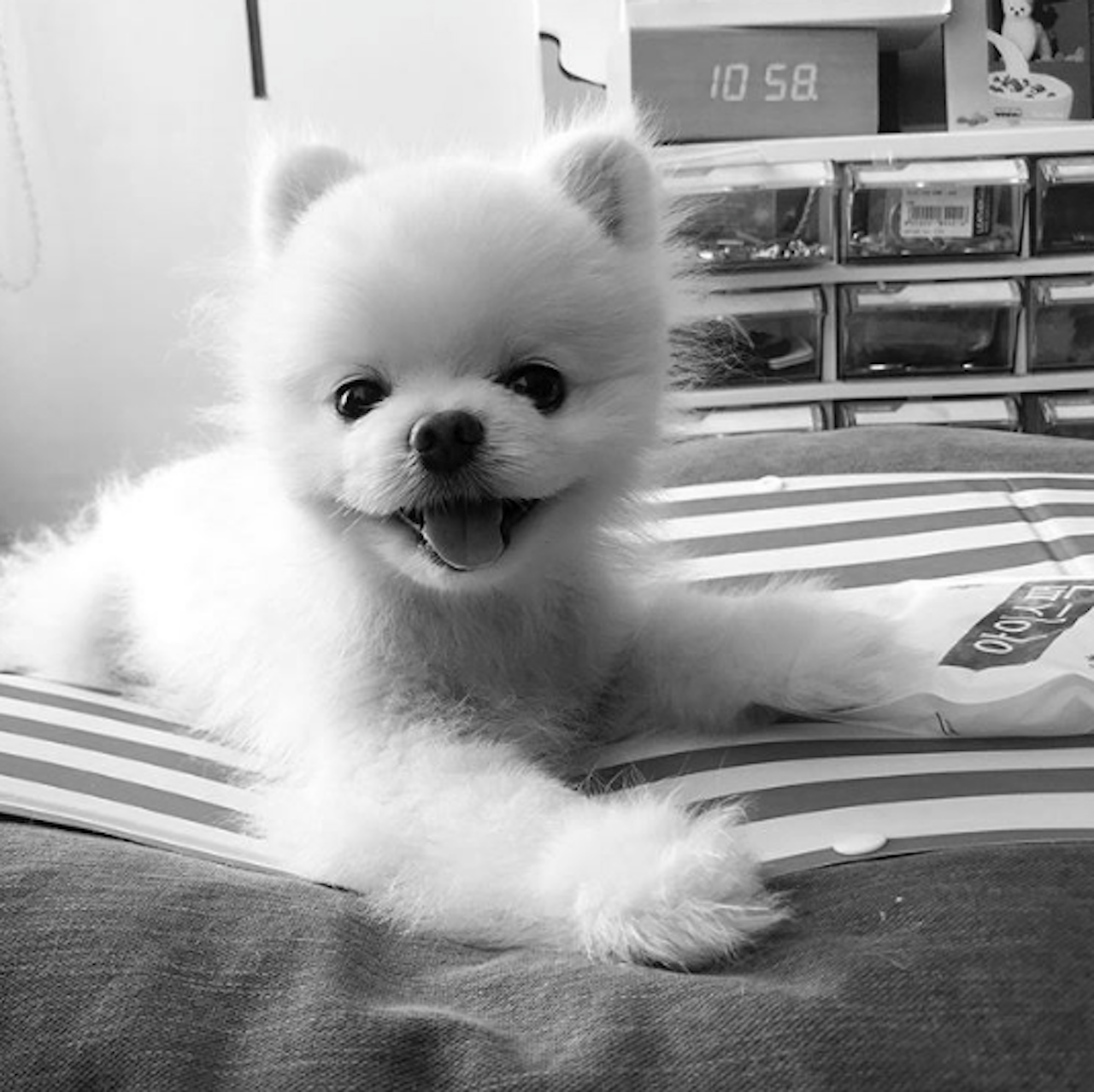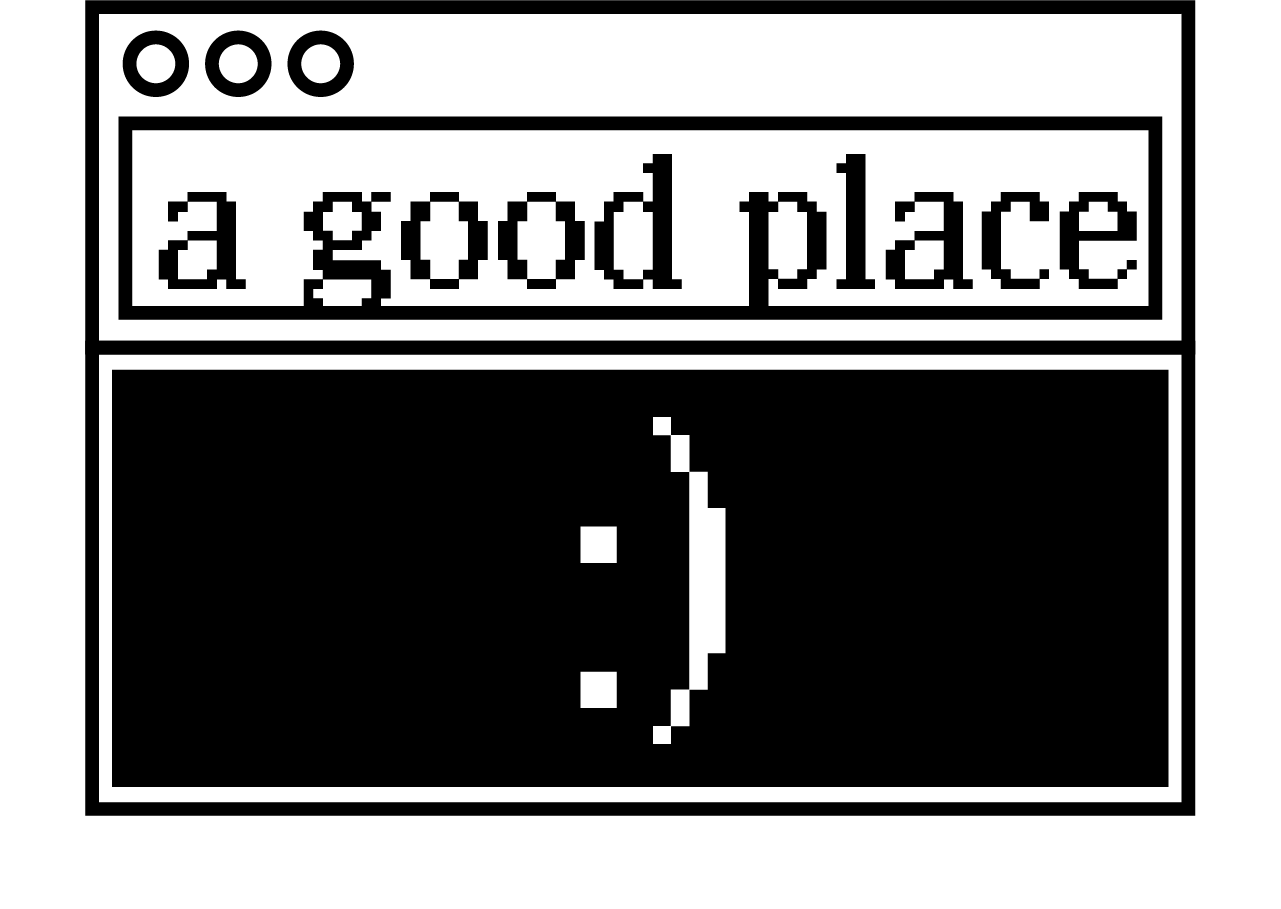but this place is just right.
Here are some facts about Tofu, my favorite dog. He is a four-year-old white male Pomeranian residing with his owner somewhere in South Korea. His hair is typically cut short but sometimes allowed to grow shaggy, like a beloved stuffed animal gone too long without a wash. This is a marked improvement over 2017, when Tofu suffered a mysterious and thankfully temporary case of doggy alopecia, mostly on his belly and back, allowing his pink skin to peek through. He has 179,000 Instagram followers, and a less successful YouTube page. His favorite toy is a pink octopus with red spirals for cheeks, often chewed at the top. His paws are pink except for a single left pad, which is unexplainably but adorably brown. He has many expressions, but two recurring ones: a neutral face which nonetheless gives the sense of a human in deep, melancholic thought; a wagging tongue emerging from a mouth that, unmistakably, is smiling.
But is Tofu smiling? Is Tofu, for that matter, melancholy? It’s impossible to say, but I feel confident imagining he is, because I am no dilettante in all matters Tofu. Since 2014, when I first started following the account, I’ve consumed somewhere in the low thousands of Tofu photos, and Instagram-liked many of them. I’ve attempted to auto-translate a Korean website purporting to sell Tofu-branded keychains (it remained inscrutable); I’ve DMed the particularly adorable photos to other dog enthusiasts I know; I’ve received phone notifications alerting me that Tofu is hosting an Instagram Live session, and immediately swiped the app open so that I could begin mashing the “like” button aside hundreds of other followers, our hearts fluttering up the side of the screen like carbonated bubbles.
Dog ownership has always been a vicarious interest of mine. My mom is allergic to dogs and cats, so growing up our only pets were fish and birds. Adopting one in college was out of the question; same for when I moved to New York, and lived exclusively in tiny apartments alongside cluttered roommates. Even as I’ve graduated to larger spaces, I’ve never seriously considered it. I have many friends with small — and even large — dogs in their relatively miniaturized urban spaces, but the thing about never owning a dog is that it takes a leap of faith to wake up one day and say “I think it’s time,” or at the very least a tolerant landlord. So, for now, I enjoy the dogs of friends, and the dogs on the internet.
One amazing thing about the modern internet is how it’s built to enable my enjoyment of dogs I do not personally know. A relatively popular genre of journalism addresses the ever-present algorithms guiding our daily choices from music discovery to salad selection, and why they are “bad,” or, if the author is a contrarian or Mark Zuckerberg, why they are “good.” But there is one uncomplicated net positive in favor of the algorithms, as far as my consumption goes: Today, in 2019, I am familiar with roughly 3000 percent more Korean pomeranians than I was five years ago.
Besides Tofu, there’s Mango, a chestnut-colored pom often seen with a baby (!); Gyeonwoo, a black-and-white sweetie whose bio defiantly states “ɪ ᴀᴍ ᴘᴏᴍᴇʀᴀɴɪᴀɴ ɴᴏᴛ ʀᴀᴄᴏᴏɴ”; Dotory and Donuts, a pair of cream and caramel-colored sisters the size of tea cups; and Wanza, whose floofy little squished face is so precious I could honestly die. Dozens more proliferate across Instagram, many of whose profiles are suggested to me by the app’s algorithm, which has rightly intuited that I “enjoy pomeranians.”
I don’t know how I first came across Tofu, but I’m pretty sure I know how I learned about Mango: because she was photographed hanging out with Tofu. I definitely know how I learned about Dotory and Donuts: because they were photographed with Tofu and Mango. Same for Gyeonwoo, Gom and Ha-eum, Baki and Doobo, Ardu and Abon, and so many more. If you follow one Korean pomeranian for more than a few weeks, you’ll eventually spot them with another adorable pomeranian. And when you follow that pomeranian, you’ll soon learn about some others, and pretty soon your feed is just wall-to-wall dogs. The next step is following a recommended tag: #화이트포메, or “white pomeranian” in Korean, presenting countless more dogs — many with a low follower count, having piggybacked onto the tag in order to ensnare suckers like me — for your pleasure. Good friends will text you things like “Sometimes I see you like, like, seven Instagram pics of poms in a row” and you will know they are not exaggerating. They’re a balm against a dreary day, a different dog with a ridiculous face providing an instant flicker of joy.
Cute dogs are popular almost everywhere in the world, but Michael Pettid, a professor at Binghamton University’s Department of Asian and Asian American Studies, told me that dog ownership in Korea has become “a social event for a certain class of people. There’s a degree of importance that will be associated with that, if you could afford a pomeranian that you’re paying thousands more dollars for, and taking care of it at the top level.” The size of your average pomeranian makes them a better fit for small apartments, which Korean citizens increasingly occupy. Younger Koreans are also more comfortable with keeping dogs inside the house as pets, which pairs with a generational rejection of the dog meat industry.
Pomeranians, of course, are not the only cute dogs beloved by Koreans; they’re just the ones I happen to follow. And that all of these dogs seem to know each other is a feature of geography: South Korea is a small country, largely concentrated in big cities, allowing owners to more easily meet up for these staged photo shoots. Why would anyone spend hours taking photos of their dogs together? Well, because it’s adorable. But each of these dogs participates in sponsored content, posing with products every few weeks. Here’s a semi-exhaustive list of products and brands that appeared on Tofu’s feed between July 2018 and January 2019: Nike, Macaroons, Tommy Hilfiger, Vetements, Kith, some kind of vacuum-sealed dog food, Laminarof soothing lotion, Cheese Sun brand dog food, non-alcoholic Dogwine, a vacuum cleaner, a different vacuum cleaner, some kind of turntable treat device, more Laminarof, more dog food, and human loungewear. Business is very good, if you’ve got a cute enough dog, and it pays to do a little travel.
There is something faintly insidious about this, yes. Monetizing your dog’s cuteness to lubricate the flow of commerce is craven, plus there’s the fact that dogs this specifically small and cute are almost certainly obtained from breeders and puppy mills, which can only be regarded with disgust. Dogs of this size are also likely to suffer from health problems such as breathing issues and things with names like “hip dysplasia” and “luxating patella,” both very common conditions in pomeranians meaning their back hips and kneecaps, respectively, are constantly in danger of being dislocated. Pettid told me the culture of dog adoption and rescue in Korea simply does not exist, compared with America, and that historically, dogs are abandoned when they reach a certain, infirm age. Only a couple of the pomeranians I follow are more than a few years old.
I’d like to think that when Tofu is a little more long in the tooth, he won’t be so easily discarded, but there’s nothing guaranteeing that besides a blind faith in the owner’s decency. Tofu’s owner seems to genuinely care for him, but what do I know about him? What can you really ever know about anyone? Two of the accounts I used to follow have deactivated this year, for reasons unknown. I also shudder at my part in enabling “owning a dog” as an identity, thus inspiring future narcissists to wrench their thousand-dollar designer pups from the void of nothingness, and onto an Instagram page for all to enjoy.
Yet something in my brain taps out when I force it to consider these larger issues, because, well, look at Wanza. Look at him! Reason and logic collapse against that fucking face. If it’s bad to shower the byproduct of a cruel industry with so much digital love, we all have our vices, and this is healthier than Mountain Dew or crystal meth. When pet ownership becomes a reasonable idea, I’ll certainly adopt a more realistic dog than these incandescent nuggets. For now, I absorb every new photo of Tofu, Wanza, Mango, Dotory, and all of the other poms in this network. I wonder what they’re thinking, though the obvious answer is nothing urgent besides “treats!” and “play!” If a depressing fate awaits them, they can’t conceive of the future. They are just cute, and give me renewable happiness, and so I keep following, even though I can imagine what awaits.

